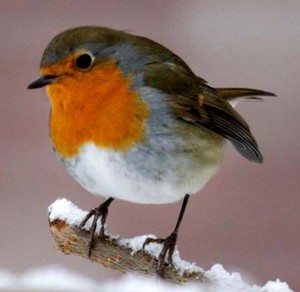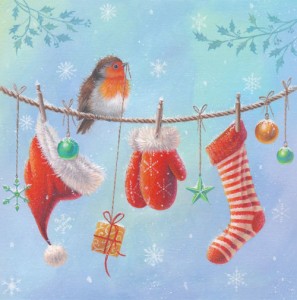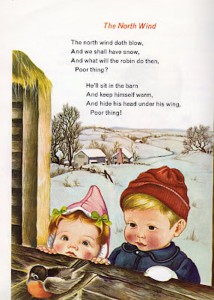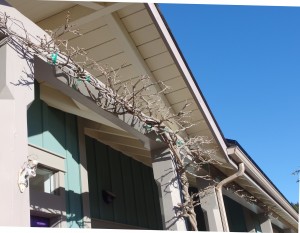Posts Tagged ‘seasons’
Robin redbreast on a fence
I still ponder why it meant so much, that Christmas morning in England in the 1960s, that a robin sat on the back fence. The field behind the fence was white, the fence wires thick with hoar frost, and the little red-breasted bird made the scene perfect. Finally, I told myself, a ‘real’ Christmas.
I have tried for many years to clarify my feelings about the disconnect between the traditional trappings of the season and my experience of growing up in New Zealand, where the seasons are reversed. My childhood Christmas memories are of summer: the tree laden with oranges in my grandmother’s garden where we hung our presents and picnicked on the lawn; the scent of magnolia blossom outside the church on Christmas Eve.
Also the Christmas cards with their images of snow (which I’d never experienced) and yes, the English robin. I knew about robin redbreast from the old nursery rhyme, but until that Christmas I hadn’t seen one.
Now on the coast of Northern California, I have a different understanding of how to celebrate the winter season. Our multicultural society recognizes many winter festival stories and traditions: the birth of Jesus in a stable, the menorah candles of Hannukah, the Swedish light-bringer St. Lucia, the gift-bringer St. Nicholas (known also as Santa Claus), and many others. The celebration that holds the deepest meaning for me now is Winter Solstice, the return of the light. From summer to winter, I note where on the horizon the sun sets, and how the darkness grows. Even as clouds gather, the place where sun disappears into ocean fogbank moves steadily to the south. When the prevailing westerly wind shifts to the southeast, I know to expect the winter rains. Sometimes a shower or two, sometimes, such as this past week, a prolonged deluge that floods rivers, downs power lines, and closes roads.
Meanwhile, the earliest spring flowers are breaking bud, and over-wintering birds gather hungrily at my feeder: Steller’s jay, spotted towhee, hermit thrush, acorn woodpecker, hordes of white-crowned sparrows. I love them dearly. I am happy that I have learned to understand the connection between the flow of seasons and human efforts to explain them with stories and festivals. And I still have a place in my heart for the memory of that cheery robin redbreast who brightened an English winter.
Pruning the Wisteria
I spent the morning pruning the wisteria vine that grows along our front porch. Up and down the tallest stepladder, leaning over the porch beam to reach the longest stems, I snipped and thinned. Each time I do this task, I remember with gratitude the workshop I attended years ago at the Elizabeth F. Gamble Garden in Palo Alto. “Be ruthless if you want flowers,” the instructor said. Ruthless I am. Otherwise the new growth pushes between the porch beam and ceiling, wraps itself round the lamp above the front door and seeks to enter the house itself.
Wisteria is not for the faint of heart. In May, as soon as the magnificent double purple flowers have bloomed and dropped, the new stems start growing. If left their own devices, they can reach ten feet in a year. As soon as they threaten to strangle visitors at the front door, I whack back as many as I can reach with my pole pruner. I may have to do this several times during the summer. In fall I haul out the big stepladder and take back all the foliage to somewhere near its supporting wire. However, in our mild coastal climate, the leaves don’t drop until well into the winter. It’s only then that I can see the structure I have trained over the years and can scrutinize each branch that sprouts from the main stem, looking for crossed twigs, dead wood, and stems facing back toward the house.
It’s a strenuous task. But when it is done, the prunings composted and the porch swept, there’s such a sense of satisfaction in looking up at the vine and seeing the shape of it against the house.
Rain
This last month of our annual dry season, as grasses turn dusty brown and the trees droop, a phrase from a Gerard Manley Hopkins poem has been running through my head: “Send my roots rain.” This week the first good downpour broke the drought. I found and reread Hopkins’s poem, and recognized in it the cry of every writer who, like myself, goes through a dry spell and pleads for the rain of words and ideas.
Hopkins’s sonnet begins as a Job-like argument with God. He is angry that “sinners’ ways prosper” while he, a Jesuit priest who spends his life “upon thy cause,” sees his every endeavor end in disappointment.
The tone shifts in the second part of the sonnet. Hopkins points out the exuberant natural world:
See, banks and brakes
Now, leavèd how thick! lacèd they are again
With fretty chervil, look, and fresh wind shakes
Them; birds build …
He compares these images with his own struggles. He does not build, he says,
but strain,
Time’s eunuch, and not breed one work that wakes.
Hopkins sold himself short, of course. His poems continue to waken in the minds of later generations. But that sense of self-doubt is one all writers share. Whatever our spiritual beliefs, we can join in the prayer of Hopkins’s closing line:
Mine, O thou lord of life, send my roots rain.
You can read this sonnet, and link to other poems by Hopkins, at http://www.poetryfoundation.org/poem/173669
Striking a Balance
A gloriously clear day after the first big rain of the season, and the garden calls. Where to start? I need to strike a balance between our enjoyment of beauty and the garden’s needs. The lavender still gives off its evocative scent, and its color is still purple, a gray-purple, like twilight clouds. But if I leave it much longer the stems will die off. Besides, more rain is due in a couple of days, so soon the soil will be too wet to walk on. The task has to be done today.
Even now, where to cut is a challenge. Snip too high, and each rounded bush will resemble a pincushion. Too low, below where a small gray-green pair of leaves has sprouted, and the stem will die anyway. I don’t have time to manicure each individual stem. I take a breath, grab a handful of stems, and cut.
A flotilla of coyote bush seeds sails by on the wind. Negotiating the balance between garden plantings and native vegetation on this stretch of the Mendocino Coast requires the patience and skill of a diplomat. Coyote bush was here first, and provides excellent forage for the small, seed-eating birds that flock here in the fall. Douglas fir grows here too, and Douglas iris, and blue-eyed grass. Again, a balance. The Douglas fir seedlings have to go if they are close to the house. Iris and blue-eyed grass get to stay. Coyote bush, the most prolific, I allow on the outskirts of the garden. But here where it would crowd out the lavender, no. I reach down and yank out babies from between the lavender bushes.
Catching my breath
Countdown to the Mendocino Coast Writers Conference, which starts next Thursday, July 29. Amazingly, I’m caught up for the moment on co-director tasks. Time to take a deep, relaxing breath and think about the wealth of wildlife with which this place is blessed. Last evening, on the hill behind our house, we saw our first California gray fox of the season. A cottontail scampered out of sight as a pair of angry scrub jays attacked the fox. Later, the stags emerged, two of them, both with magnificent six-point racks of antlers. We’ve been watching the new season’s fawns gradually lose their spots. A jack rabbit family shares the front garden with the quail family. Hummingbirds and bees have discovered an exotic treasure from my native New Zealand: a young Metrosideros excelsus. It is commonly known as New Zealand Christmas Tree because on the northern coast of New Zealand its spectacular clusters of red flowers bloom in December. Here on the other side of the world, where summer is on the other side of the calendar, it has been brightening our gray July. We call it by its Maori name, Pohutukawa.
Where the flowers are
It is one thing to know as a fact that high rainfall tallies in California’s rainy season result in more spring wildflowers. It is quite another thing to feel with your whole being that exuberant burst of fecundity.
At MacKerricher State Park this morning the air is misty and the sea is calm. Out by Laguna Point, swathes of Goldfields (Lasthenia chrysotoma) dazzle the eye. Up close, I see that among the Goldfields are patches of Purple Butter & Eggs (Triphysaria eriantha ssp. rosea) whose complementary color makes the gold even more eye-popping. Scattered among them are California Poppies (Eschscholzia californica). Not the orange poppies we coast dwellers snobbishly refer to as freeway poppies, but our own coastal variety, the leaves more fleshy to resist the salt wind, the flowers a prettier yellow.
South along the headlands trail, I know a place where Coast Delphinium (Delphinium decorum) grows. Never more than a foot high, each plant has a head of deep blue flowers that glow with intensity. This year they are magnificent. As I crouch to admire, I remember renewing their acquaintance in previous springs.
This is the way an immigrant learns to belong: to come back and back to a place, to remember its varied moods, to remember where the flowers are.
Christmas Eve
The last of a wintry sun touches the leaves of the olive tree in my garden. The resident Anna’s hummingbird gathers the last beakful of nectar and comes to perch. A burbling of quail under the bushes. Peace on earth.



